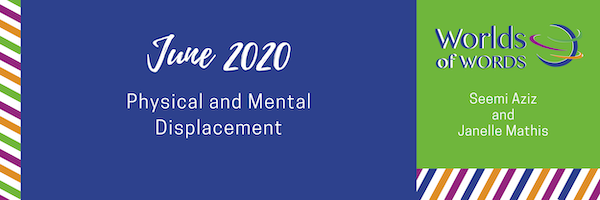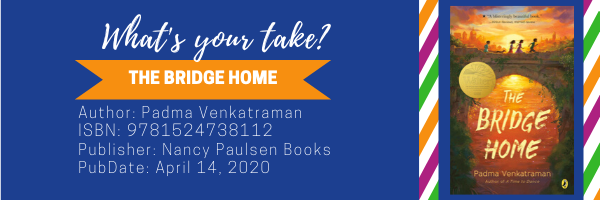 By Seemi Aziz, The University of Arizona, Tucson, AZ and Janelle B. Mathis, University of North Texas, Denton, TX
By Seemi Aziz, The University of Arizona, Tucson, AZ and Janelle B. Mathis, University of North Texas, Denton, TX
As we read contemporary stories about immigration, developing identity, bullying, children facing inequities and challenges in their families, schools, communities, and many other social issues that serve to give voice through story to children everywhere, we see that displacement is a theme woven throughout these stories. Both physical and mental displacement are experiences not uncommon to all young people since the world ‘displacement’ implies being removed from that which is known, comfortable, or expected. If approached in a way that points to the many aspects of displacement that align with everyday experiences, as well as to those experiences that are the result of conflict, trauma or conditions out of the control of the child, these characters can reveal personal attributes that support actions, decisions, and personal perspectives in times of displacement. Such attributes are demonstrations of resiliency and agency in the face of challenge.
In the past few months, globally, both children and adults have been dealing with a variety of forms of displacement–removed from their daily workplaces, activities, interactions with others, and even how they attend to everyday needs. The displacement as a result of the COVID-19 pandemic involves both mental and physical challenges, and yet, we need reminders that these can be met critically, creatively, and successfully. Therefore, this month, we wanted to respond to books that reveal children placed in situations of displacement with the hope that the way in which they handle their situations reflects attributes and actions that speak in hopeful ways to the challenges of readers. For the first two weeks, we will share a novel each week in which a global context reveals children dealing with extreme situations of displacement. In the following weeks, we will suggest other books, inclusive of picture-books, that provide diverse perspectives and situations around the topic of displacement–books that examine displacement in everyday situations and for varied ages of readers.

The Bridge Home by Padma Venkatraan provides opportunities to think about displacement with its multiple potential themes. Viji and Rukku run away from home to the city as a result of the actions of an abusive father. One reason for this escape is Viji’s promise to protect her sister Rukku, who is withdrawn and mentally/emotionally challenged. We learn this through the author’s description of Rukku’s actions and limited speaking. As for many children in this town of Chennai, India, the sisters must seek shelter and food on their own. Fortunately, they become friends with two homeless boys and together they form a family unit of sorts, facing life on the streets together. They survive by searching for sellable trash and complementing each other’s needs until illness strikes and they realize they have to seek help beyond themselves.
JANELLE: As I reflect on this book in light of the notion of displacement, I find numerous actions and interactions that speak to the strength of these characters. One, is the growth in Rukku throughout the story. She had been bullied in school for being slow when we first meet her in the novel, but once the sisters are established in the city and building a friendship with the boys, Rukku begins to show her ability to take responsibility, to understand situations and to open up socially. The boys are quick to let her take part in daily events, even when her sister, Viji, is hesitant due to her protective role. Giving Rukku a voice and chance to contribute to the “family” creates a context for her identity to develop. The physical displacement from home, which Rukku does not seem to understand at first, is actually an escape from the mental displacement in which she initially lives. Displacement does not have to result in a negative situation, but the context to which one is displaced can create a positive outcome through relationships that support personal needs.
Viji, as well, succeeds in this new environment, although her goal of becoming a teacher seems far removed from the requirements of survival. Ultimately, and not without sadness, her sense of responsibility, self-dignity and confident decision-making brings her to a hopeful ending where her goal is in sight. While her physical displacement is her own decision, it is a result of the mental displacement within her original home, created by her father, that makes leaving home necessary. Her flight to the city results in a new sense of mental displacement–one that requires her to focus on different challenges of survival, but one that she believes she can now control and proceeds to do so. While not every child can be so resilient to issues of hunger and poverty, the author’s note at the end addresses that many children’s problems “result from a lack of understanding, lack of resources, or lack of compassion.” This is a strong global message to consider in light of this story based on collected first-person accounts.
SEEMI: As I read this book I sense an insider writing the story, albeit with an agenda of exploring multiple issues faced by children all over the world, but mostly, within the so-called “third world” countries. The issue of displacement is, by far, front and center as is the concept of home. As the girls, and the later the four children (Viji, Rukku, Arul and Muthu), move from home to under-the-bridge/home to the cemetery/home and then finally to Aunty Celina’s refuge/home, they find and create a sense of self and dignity while they struggle to create a sanctuary for themselves. As they battle filth and perpetual hunger, Viji never looses her grip of the reality that is hers alone. Rukku’s character moves from being challenged and slow to a more confident person who becomes the major monetary contributor through crafting beautiful, sellable necklaces. The common occurrence of children’s death is a theme that is highlighted before Rukku’s passing within the story and lends to the reality of the ultimate sacrifice made by children all over the world as if their lives do not matter.
Even though this story seems a necessary tale that needs to be voiced, it reads as forced and didactic at times due to highlighting of the issues faced by poor children in India. As the children finally find security and “home” in Aunty Celina’s refuge, they feel confident for the future that seemed nonexist thus far. My concern with this aspect of the story is that I find that the Christian-as-savior reflects the usual white as savior theme, which is typical when we see books about children belonging to the regions that struggle economically. The story of displaced Japanese brother and sister in the animated film, The Grave of the Fireflies resonates with this story through the powerful themes of displacement, loss and death.
[Admin Note: The Bridge Home was our WOW Recommends: Book of the Month for October 2019 and also featured our August 2019 My Take/Your Take.]
Title: The Bridge Home
Author: Padma Venkatraman
Publisher: Nancy Paulsen Books
ISBN: 9781484781517
Date Published: February 5, 2019
Throughout June 2020, Seemi and Janelle give their takes on books that feature physical and mental displacement. Check back each Wednesday to follow the conversation!
- Themes: Bridge Home, Janelle Mathis, Padma Venkatraan, Seemi Aziz
- Descriptors: Books & Resources, My Take/Your Take
